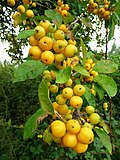| Macromeles tschonoskii | |
|---|---|
 | |
| Scientific classification | |
| Kingdom: | Plantae |
| Clade: | Tracheophytes |
| Clade: | Angiosperms |
| Clade: | Eudicots |
| Clade: | Rosids |
| Order: | Rosales |
| Family: | Rosaceae |
| Genus: | Macromeles |
| Species: | M. tschonoskii |
| Binomial name | |
| Macromeles tschonoskii | |
| Synonyms [2] | |
| |
Macromeles tschonoskii (common names Chonosuki crab and pillar apple) is a species of flowering plant in the family Rosaceae. It is a tree endemic to Japan. [2]
Contents
The specific epithet tschonoskii refers to the 19th century Japanese botanist Sugawa Tschonoski. [3]

